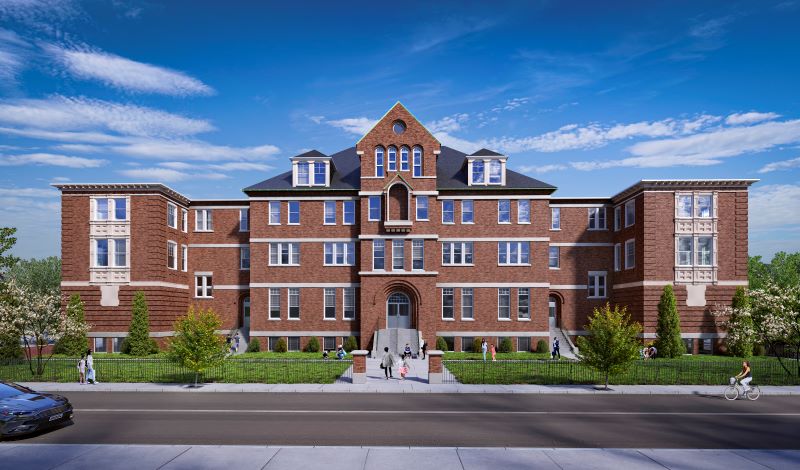States, Municipalities, and Developers Work in Tandem to Build Affordable Housing Customized for Local Communities
By Pamela Martineau
7 min read
Some states have recently taken innovative measures to empower local communities and developers in constructing affordable housing projects that address the specific needs of the communities they serve.
New England offers two prime examples of state funding initiatives that encourage developers and communities to work together on specialized affordable housing to meet the needs of the communities involved. In Massachusetts, Gov. Maura Healey signed a $1 billion tax relief bill in 2023 that raised the Low Income Housing Tax Credit (LIHTC) from $40 million to $60 million a year. That increase helped to build a package of $158 million in LIHTC and subsidy awards to fund 14 affordable housing projects in municipalities dubbed Gateway Cities by the state. Gateway Cities are mid-sized urban centers with economic challenges and unrealized potential.
Boston-based Cruz Companies is a firm that was awarded funds for its development projects in four sites in New Bedford, MA, a Gateway city.

“New Bedford is a Gateway City with a lot of improvement going on,” says Daniel Cruz Jr., senior vice president of Cruz Development Corporation. “They are moving the needle as it relates to housing.”
In neighboring New Hampshire, Gov. Chris Sununu allocated $7.9 million in planning grants to allow municipalities and regional planning commissions in the state to hire staff to facilitate community discussions on housing and study barriers to affordable housing. The Community Housing Navigator Program and Housing Opportunity Planning (HOP) grants help communities develop housing proposals to fit their specific needs.
New Hampshire Housing, a public corporation dedicated to promoting housing solutions, in partnership with UNH Cooperative Extension, used a portion of the funds to develop a Housing Academy, a training program designed for grantees to create community engagement tools and techniques. In January, New Hampshire Housing released a report highlighting several adopted solutions developed by local jurisdictions.

“It’s tailored solutions. All our communities in New Hampshire are different,” explains Sarah Wrightsman, manager, community engagement and education at New Hampshire Housing. “Every community is going to approach the solutions to the housing crisis in a way that makes sense for them.”
New Bedford, MA Scattered Sites Project
Cruz Companies is finishing up the architectural drawings for a four-site project in New Bedford that, when completed, will feature 83 units. The project consists of the rehabilitation of three historic buildings and the construction of one building, all in different corners of the city.
“Each takes up an entire city block, so when finished, they will impact entire neighborhoods,” says Edgar J. Carrere, senior real estate project manager, Cruz Development Corp.
Daniel Cruz explains that the city of New Bedford is trying to create a wider range of housing opportunities. To meet that goal, the project will target a wide range of tenants. Of the 83 units, 34 will target the elderly. The new projects will also serve people making 30, 50, 60, or 80 percent of area median income (AMI) and offer some market-rate apartments.
“Having multiple people from different AMIs adds to the fabric of those communities,” says Justin Cruz, chief operating officer of The Cruz Companies.
“You could make as little as 25 thousand a year as a single person and up to 85 and 90 thousand,” adds Daniel Cruz.

Cruz Development Corporation has worked closely with the city of New Bedford on the project, both on the design and occupancy goals. The city provided a $1.8 million loan that the project’s cash flow will service. Cruz says the biggest part of the project funding is $39 million in tax credit equity – federal and federal historic, as well as state and state historic. The project will carry $6.5 million in debt at low rates, from the state, with cash flow from the project servicing much of the debt. Additional soft money loans of approximately $9.1 million are from both the city and state.
Cruz explains that the state and the city “want their money back” but are “most interested in housing and opportunity” for the community.
“With the state, it is virtually a requirement that you have local input into a project, meaning with cash,” explains Carrere. “This shows that the local government is committed…that they want to see affordable housing constructed in their communities.”

Leveraging Local Impact
Justin Cruz says that Cruz Companies seeks to leverage their developments so they create the biggest local impact, not just through creating affordable housing, but by increasing job growth and bolstering local economies. Mixed AMIs help to reach that goal because those in higher incomes often have a bigger impact on retail sales, Justin Cruz says. Cruz Companies also tries to hire locally, maintaining an average of 60 percent of its workforce—construction workers, architects, electricians, and more—coming from the community they are building in or nearby communities.
“We always have high goals for local workers. Sixty percent is just the average,” says Justin Cruz. “We often go higher.”
Daniel Cruz says the effort to hire locally is part of the strategy to use development to impact a community economically.
“You don’t want to just put up a building,” says Daniel Cruz. “Buildings are beautiful…but you want to do more than that. You want to empower economically and create the most impact.”
Developing Affordable Housing Visions One Community at a Time
For the past three years, residents in communities across New Hampshire have been meeting in facilitated groups to hash out how they would like to meet their respective community needs for housing, especially affordable housing. Funded through state planning grants, the communities have developed some innovative housing proposals to meet their specific housing needs.
“They developed a whole range of solutions to be applied locally,” explains Wrightsman of New Hampshire Housing. “They all did something interesting in their way.”
New Hampshire Housing released a report showcasing the work of the 72 communities that developed proposals through HOP grants. The report also offers case studies on 11 of those communities. The housing solutions proposed by the communities range from amending the community’s accessory dwelling unit (ADU) ordinance, focusing on “missing middle” housing types, developing a “cottage cluster” ordinance, farmstead design alternative, or increased densities.
Funding for the initiative came through the state’s allocation of American Rescue Plan Act (ARPA) State and Local Fiscal Recovery Funds (SLFRF). Wrightsman says those funds had to be obligated by the end of 2024 and spent by the end of 2026. No additional funds have been identified for the program, she says.

Proposed Increase in Low Income Housing Tax Credits for States
Daniel Cruz says he envisions more local development driven by state governments if a bill pending in the U.S. House of Representatives is signed into law. The bill, the Affordable Housing Credit Improvement Act of 2025, HR 2725, would, among other things, increase the amount of LIHTC allocations for each state by 50 percent equally over the next two years. The number of deals done with Private Activity Bonds could also double with the pending legislation.
“It would double the resources available,” says Daniel Cruz.
Passage of the bill would not only increase the amount of affordable housing that could be built, but it would also speed up construction, says Cruz. Right now, their New Bedford project is waiting in a tax credit queue in Massachusetts, which could be as long as two years before it can move forward.

